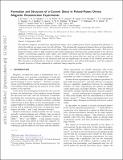Formation and structure of a current sheet in pulsed-power driven magnetic reconnection experiments
Author(s)
Hare, J. D.; Lebedev, S. V.; Suttle, L. G.; Ciardi, A.; Burdiak, G. C.; Chittenden, J. P.; Clayson, T.; Eardley, S. J.; Garcia, C.; Halliday, J. W. D.; Niasse, N.; Robinson, T.; Smith, R. A.; Stuart, N.; Suzuki-Vidal, F.; Swadling, G. F.; Ma, J.; Wu, J.; Gomes Loureiro, Nuno F; ... Show more Show less
Download1705.10594.pdf (8.845Mb)
OPEN_ACCESS_POLICY
Open Access Policy
Creative Commons Attribution-Noncommercial-Share Alike
Terms of use
Metadata
Show full item recordAbstract
We describe magnetic reconnection experiments using a new, pulsed-power driven experimental platform in which the inflows are super-sonic but sub-Alfvénic. The intrinsically magnetised plasma flows are long lasting, producing a well-defined reconnection layer that persists over many hydrodynamic time scales. The layer is diagnosed using a suite of high resolution laser based diagnostics, which provide measurements of the electron density, reconnecting magnetic field, inflow and outflow velocities, and the electron and ion temperatures. Using these measurements, we observe a balance between the power flow into and out of the layer, and we find that the heating rates for the electrons and ions are significantly in excess of the classical predictions. The formation of plasmoids is observed in laser interferometry and optical self-emission, and the magnetic O-point structure of these plasmoids is confirmed using magnetic probes.
Date issued
2017-09Department
Massachusetts Institute of Technology. Laboratory for Nuclear ScienceJournal
Physics of Plasmas
Publisher
AIP Publishing
Citation
Hare, J. D., et al. “Formation and Structure of a Current Sheet in Pulsed-Power Driven Magnetic Reconnection Experiments.” Physics of Plasmas, vol. 24, no. 10, Oct. 2017, p. 102703. © 2017 Authors
Version: Author's final manuscript
ISSN
1070-664X
1089-7674